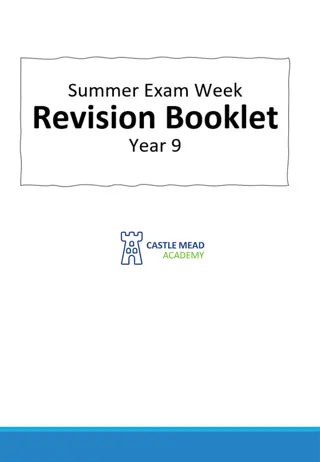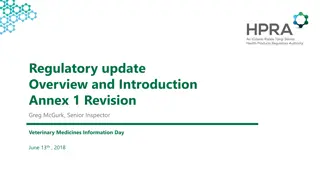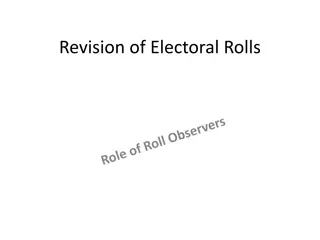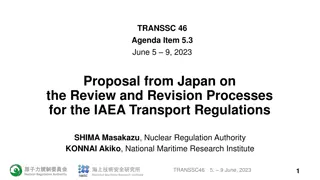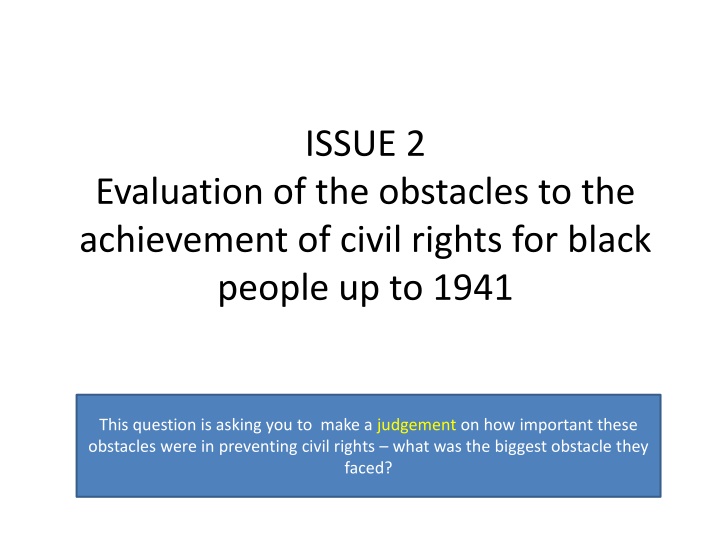
Obstacles to Civil Rights for Black People Up to 1941
Explore the evaluation of obstacles hindering civil rights for black people until 1941, analyzing factors like divisions within the black community, activities of the Ku Klux Klan, popular prejudice, lack of political influence, and legal impediments. Discover how these challenges impacted the struggle for civil rights amid historical contexts such as the Constitution's 13th and 14th amendments, the Emancipation of slaves, Jim Crow laws, and more.
Download Presentation

Please find below an Image/Link to download the presentation.
The content on the website is provided AS IS for your information and personal use only. It may not be sold, licensed, or shared on other websites without obtaining consent from the author. If you encounter any issues during the download, it is possible that the publisher has removed the file from their server.
You are allowed to download the files provided on this website for personal or commercial use, subject to the condition that they are used lawfully. All files are the property of their respective owners.
The content on the website is provided AS IS for your information and personal use only. It may not be sold, licensed, or shared on other websites without obtaining consent from the author.
E N D
Presentation Transcript
ISSUE 2 Evaluation of the obstacles to the achievement of civil rights for black people up to 1941 This question is asking you to make a judgement on how important these obstacles were in preventing civil rights what was the biggest obstacle they faced?
Possible questions 2013 - To what extent were divisions within the black community the main obstacle to achieving civil rights before 1941? 2012 - How far can it be argued that the activities of the Ku Klux Klan was the most important obstacle to the achievement of Civil Rights for black people up to 1941?
CONTEXT Constitution 13th and 14th amendments to civil and voting rights Emancipation of slaves 1865 slavery abolished State authorities did not allow these Jim Crow laws passed after the Separate but equal ruling perpetuated this racial inequality.
KKK Divisions in black community Popular prejudice OBSTACLES Lack of political influence Legal impediments
KKK KU Originally formed in 1860s with direct purpose to prevent former slaves enjoying equal rights Resurgence in 1920s, in order to protect the American way of life . Hiram Wesley Evans - leader in 1923. By 1925, 3 million members, many of which were police, judges and politicians. Tactics of lynching, torture and violence characteristic of this secret organisation.
KKK ARGUMENT A SIGNIFICANT obstacle: Lynching resulted in a black population too terrified to campaign for fear of the consequences. Roosevelt refused to support an anti-lynching bill in his New Deal for fear of losing Democrat support in south therefore allowing lynching to continue unpunished. 1925 March on Washington permitted showed their support In some states, only KKK approved candidates could stand for election proving their political power. By 1920s, scandals discredited KKK. In Alabama where they were most powerful numbered less than 6,000 by 1930 but they remained powerful in local groups.
DIVISIONS IN BLACK COMMUNITY KU Booker T Washington, accomodationist philosophy, regarded as an Uncle Tom by many he argued not to antagonise whites but prove themselves through hard work and education. W. E. B. Du Bois disagreed with Washington he said this approach assumed that blacks were inferior and fought for complete racial equality. W E B De Bois founded the NAACP a national organisation whose main aim was to oppose discrimination through legal action. 1919 he campaigned against lynching, but it failed to attract most black people and was dominated by white people and well off black people Marcus Garvey and Black Pride he founded the UNIA (Universal Negro Improvement Association) which aimed to get blacks to take Africa, organise it, develop it, arm it, and make it the defender of Negroes the world over . This Negro nationalism was very popular as it rejected white culture. 1922 6 million members. However, Garvey s fraudulent activity discredited him. 1. 2. 3.
DIVISIONS IN BLACK COMMUNITY ARGUMENT Resulted in a WEAKENED campaign before 1941, lack of COHESION. DISAGREEMENT in approach and ideology. Shared goals but not the approach. Garvey did raise pride in black community. Washington s Tuskegee institution did educate black Americans who attended.
LEGAL IMPEDIMENTS KU + ARGUMENT Jim Crow Laws separate education, transport, toilets passed in Southern states after the Civil War this gave legal justification to racism. Restricted their civil rights and resulted in apathetic black Americans. Separate but Equal Supreme Court Decision 1896, when Homer Plessey tested their legality proved a significant legal obstacle Attitudes of Presidents eg Wilson Segregation is not humiliating and is a benefit for you black gentlemen . Wilson also called them an ignorant and inferior race unsympathetic president would prevent further reforms being passed that would improve civil rights for blacks
LACK OF POLITICAL INFLUENCE By 1900, almost no blacks could vote despite their constitutional right to do so therefore could not elect someone to fight for civil rights. Voting registration rules were an important obstacle. 1898 case of Mississippi v Williams voters must understand the American Constitution. Grandfather Clause: impediment to black people voting. Most black people in the South were sharecroppers they did not own land and some states identified ownership of property as a voting qualification.
LACK OF POLITICAL INFLUENCE ARGUMENT Therefore black people could not vote, particularly in the South, and could not elect anyone who would oppose the Jim Crow Laws Direct obstacle to the achievement of civil rights. Little was achieved to end discrimination, political activists were a minority. Lacked political education and experience to change this.
POPULAR PREJUDICE KU After the institution of slavery the status of Africans was stigmatised, and this stigma was the basis for the anti-African racism that persisted The relocation of millions of African Americans from their roots in the Southern states to the industrial centres of the North after World War I, particularly in cities such as Boston, Chicago, and New York (Harlem). In northern cities, racial tensions exploded, most violently in Chicago, and lynchings mob- directed hangings, usually racially motivated increased dramatically in the 1920s.
POPULAR PREJUDICE ARGUMENT Civil rights was treated with hostility. Most African Americans were more concerned with their economic survival.





